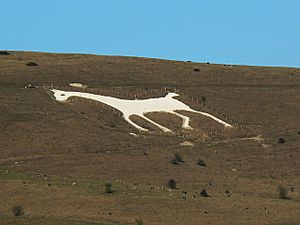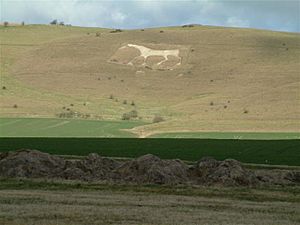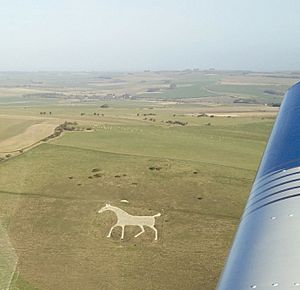Alton Barnes White Horse facts for kids
The Alton Barnes White Horse is a large chalk drawing of a white horse on a hillside. You can find it on Milk Hill in Wiltshire, England. It's about 1,000 metres north of the village of Alton, Wiltshire. This horse figure is around 180 feet (55 meters) tall and 160 feet (49 meters) long.
It was created in 1812 by a local farmer named Robert Pile. He hired a painter, John Thorne, to design and cut the horse. However, Thorne took the money and left, so another local, John Harvey, actually cut the horse. The Alton Barnes horse looks similar to another white horse figure in Wiltshire, the Cherhill White Horse. It is the second largest of nine white horses in Wiltshire.
This white horse is very popular and a well-known sight in the county. Many people visit it. It has been regularly cleaned and looked after over the years by different groups. For more than ten years, candles were used to light up the horse every winter solstice. In 2012, for its 200th birthday, it was lit up with lanterns. The horse has even been changed into a zebra twice for April Fools' Day!
Contents
Where is the Alton Barnes White Horse?
The Alton Barnes White Horse is on the southern side of Milk Hill. This hill is also called "Old Adam" by locals. It's the tallest hill in Wiltshire, reaching 295 metres high. The horse is on a ridge connecting Milk Hill to Walker's Hill. It looks out over the Pewsey Vale. This area is part of the Pewsey Down Nature Reserve.
You can see the horse from up to 22 miles away. Some of the best views are from the Honey Street canal bridge and roads near Alton Priors and Lockeridge. On a clear day, you might even see it from Old Sarum near Salisbury. You can reach the horse by following a footpath from a nearby parking area or from the top of the hill. There's a fence around the horse to protect it from animals and visitors. Close by are two Iron Age hill forts and the Adam's Grave long barrow.
The chalk horse is 166 feet (51 metres) tall and 160 feet (49 metres) wide. It was made extra tall to look right from far away. It was inspired by the Cherhill White Horse, which was cut in 1780. The Alton Barnes horse is a bit bigger. Some old records suggest it might have been even larger in the past. Author Paul Newman says the horse has a unique look with its "docked tail and trotting stance." Over time, its shape has changed a bit. Its eye became bigger, its neck thinner, and its legs were improved. Lips and ears were also added.
How the Horse Was Created
The Alton Barnes White Horse was made in 1812. Robert Pile, a farmer from Manor Farm in Alton Barnes village, ordered it. He might be the same Robert Pile who made the first Pewsey White Horse in 1785. Or perhaps it was his son, since this horse was made 27 years later.
Pile chose the southern slope of Milk Hill for the horse. He hired a travelling painter named John Thorne, also known as Jack the Painter. Thorne was supposed to design and dig out the horse. Pile paid him £20 in advance. They agreed the horse would be dug about 1 foot (half a metre) deep and filled with chalk. Thorne gave Pile a drawing of the horse. It looked like the Cherhill White Horse, but with ears outlined in chalk.
However, Thorne did not do the work himself. He secretly hired another man, John Harvey, to dig the outline. Once Harvey had started and the horse's shape was clear, Thorne left with the £20. Pile then had to pay Harvey to finish the work, or he completed it himself. Thorne later faced problems for other actions. Paul Newman, an author, says Thorne's story makes him a unique part of hill figure history. He brought a different kind of character to this art form.
Keeping the Horse Clean and Bright
The Alton Barnes White Horse has been well cared for since it was made. It has been regularly "scoured," which means cleaning and adding fresh chalk. Author Esther Smith noted that sometimes the horse has needed repairs. But it has always received enough care to keep it from disappearing.
Many different groups have helped scour the horse over the years. In the mid-1800s, people paid money to have it cleaned. Scouts, Guides, and local groups have also helped. In 1866, a chalk pit was dug above the horse's head. This was to get fresh chalk easily. But it was a mistake because the pit never fully grew over and can still be seen. During World War II, the horse was hidden from German planes.
In 1987, army helicopters helped bring in fresh chalk to scour the horse. By 2009, the horse was losing its shape and turning brown. So, the Alton Barnes Parish Council and landowner Tim Carson decided to fully restore it. This cost about £21,000. In September and October 2009, a helicopter brought 150 tonnes of fresh chalk. This gave the horse a new white coat for its 200th birthday in 2012. A parish councillor, Steve Hepworth, explained that helicopters were needed. This is because the horse is in a Site of Special Scientific Interest and a national nature reserve. Trucks are not allowed there.
In July and August 2019, hundreds of people from many countries helped scour the horse. An RAF Chinook helicopter flew in about 46 tonnes of chalk. The work was led by Rob Sutherland. Bad weather at first made it hard. But local students and their parents helped finish the cleaning.
Modern History and Celebrations
The Alton Barnes White Horse is one of the most famous white horse figures in Wiltshire. It is a "prominent landmark" visible from the Pewsey Vale and is "well-loved." The horse appeared in the 1995 music video for "Staying Out for the Summer" by the band Dodgy. It is also in many artworks, including one by Anna Dillon and a 1996 painting by Graham Arnold at the Wiltshire Museum. In the nearby village of Alton Priors, there is a stone with the horse's design carved into it.
The white horse is part of several tours. One is the 90-mile 'Wiltshire's White Horse Trail'. This walking tour visits all eight main white horses in Wiltshire. On May 10, 2011, Milk Hill became the starting point for the longest hand-gliding flight ever recorded in the UK.
Special Events and Lighting
From 2001 to 2012, the white horse was lit up every Winter solstice. This was done by the Wiltshire Crop Circle Study Group. They usually lit it on December 21st, the actual solstice day. Small groups of people placed tea lights in jars around the horse's outline. For example, over 400 candles were used in 2009. Melanie Gambrill, an event organizer, said it was amazing to watch the horse light up from a distance. The lights would move up to the horse's head and along its tail until it was glowing. In 2001, jars were placed on their sides to protect them from wind and rain. The effect was "dramatic" as the horse stayed lit despite some lights going out. In 2009, the horse was covered in snow when lit, which looked "quite spectacular."
On June 30, 2012, the white horse was lit up with lanterns. This was a temporary art project by Dave Chadwick and pa-BOOM. It celebrated the horse's 200th anniversary. It was also part of the Ageas Salisbury International Arts Festival. The nearby Devizes White Horse was also lit up at the same time. Maria Bota, the event organizer, wanted to highlight these white horses and the beautiful landscape they are in. About 100 people watched from Mark Hill. The horse was lit in different ways. First, its body glowed with swirling white lights. Then, its outline shone with a warm yellow flame. The event ended with a firework display.




